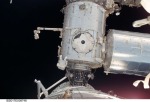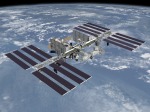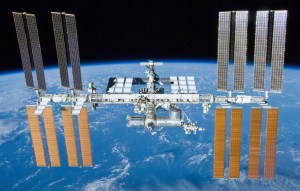The International Space Station (ISS) is an internationally developed research facility in low orbit. Construction of the station began in 1998 and is scheduled for completion by late 2011. The first section of the station was put in place by the Russians. As of May 2010, the station consists of fourteen sections. Electricity is provided using Solar Power.
The station is expected to remain in operation until at least 2015 but its more than likely going to be used until 2020.
It is the largest space station to have been constructed and can be seen from Earth without using a telescope or binoculars. On board scientists and astronauts conduct experiments in biology, chemistry, medicine, physiology and physics as well as astronomical and meteorological observations. The ISS is operated by crews of six astronauts and cosmonauts.
The station is in orbit between 278km and 460km over the Earth. It travels at an average speed of 27,743km/h. It travels around the Earth over 15 times a day (17,239.2 mph), completing 15.7 orbits per day.
It is operated as a joint project between five space agencies;
- National Aeronautics and Space Administration (NASA)
- The European Space Agency (ESA)
- The Russian Federal SpaceAgency (RKA)
- The Japan Aerospace Exploration Agency (JAXA)
- The Canadian Space Agency (CSA)
The cost of the station has been estimated to be €100 billion. It is believed to be the most expensive object ever constructed.
Life on board is packed full of activities. When they are not doing experiments astronauts and cosmonauts must exercise regularly. Muscles can become weak because of the lack of gravity. Exercising isn’t easy. When running on a treadmill the astronauts have to be tied down using bungee cords.
Eating isn’t easy either especially when your food and drink can float away from you. The main problem with eating and drinking in space is that there is no gravity. If you let go of a piece of food in a space craft, it will drift around, not fall to the floor. Water won’t stay in a cup, it will float out and hang in the air. Food crumbs and drops of water could float around the spacecraft, make a mess or even damage the space craft itself.
Scientists spend lots of time working on foods for space travel, to make sure astronauts stay fit, happy and healthy, so they can be at their best while they are in space.
Food is cooked, quickly frozen and then has the water sucked out of it in a vacuum chamber. This food last ages, without being kept cool in a fridge, and is easy to package and store on board a spacecraft.
Of course there was no water in the food at all, and while some things, like fruit could just be eaten dry, other foods needed to be mixed with water to make them edible. To prepare their meals, astronauts squeezed water into the packet of food, with a water gun, and then ate the moist food after a few minutes.
Click here to take an interactive tour of the new International Space Station.





